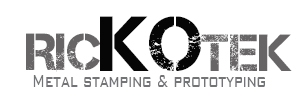For both designers and product engineers, they can quickly think that almost anything is possible due to the state-of-the-art technology that comes with computer-aided design (CAD).
When you opt to use this technology for your complex parts, your onscreen results are simply perfect. However, CAD programs tend to leave out some critical details, such as process and material limitations. So, not because you dream, it means that it can be primarily built.
Hence, the metal stamping parts that your machine produces might not be the same as what you had wished. Due to this, any experienced metal engineer will ensure that your design is discussed from early on.
The Effects Of Material Selection
One of the essential things that we know is that materials come with their thickness and hardness characteristics. When it comes to precision metal stamping, these characteristics will affect the finished product.
Therefore, thickness, the formatting area, spring back, grain direction, and hardness are all affected during stamping.
The following are some of the typical metals which are used for metal stamping:
- Stainless steel
- Ferrous and non-ferrous metals
- Titanium and various noble metals
- Aluminum
- Aluminum clad copper
- Wire
- Preplated
Before your part is manufactured, a metal stamping engineer could easily aid manufactures with selecting a material that gives the desired final product.
As such, the engineer goes on to explain the various implications as well as how the part is expected to perform. During metal stamping, some products can easily crack, and if the selected metal will, another will be suggested.
Material Swapping May Not Always Work
Additionally, there is also another common misconception that swapping out parts crafted from different materials can be working. In some cases, it may be right. However, when it comes to stamping, injection molding, and casting, this is fundamentally incorrect.
Often enough, some customers usually ask for parts that were previously crafted from plastic be done via metal stamping. However, due to the complex nature of some elements, metal stamping actually can easily make the process a bit more complicated. Along with difficulty also comes a pretty hefty price tag for some pieces due to multiple stations being used on the tool.
A simple solution to some of these is to issue changes from OEM. These quickly results in small change that significantly reduces the cost of production. It also reduces the risk of compromising the features of the part.
The Impact Of Critical Dimensions
More than often enough, a manufacturing department will submit a schematic with defined dimensions. After completion, the part goes to the quality department of OEM headquarters for approval. However, during this trip, several issues suddenly come up. These include a sudden drastic change in the dimensions.
Due to this, metal stamping manufacturers must know such dimensions before the start of the process, which ensures that they create a part to meet various dimensional requirements.
However, after the part has been built, it becomes quite challenging to deal with the various dimensional issues without being charged extra for modifications.
How To Identify The Right Dimension And Tolerance
Besides the underlying issue of critical dimension, a tighter tolerance also possesses a massive problem in some instances. Depending on the assembly or the part itself, various tolerances may be required. CAD software gives these values to several decimal points, which can be too high or too tight during production.
Additionally, according to the Precision Metalforming Association, all sharp edges and corners must be removed. This is one condition that must be addressed when it comes to deburring.
Hence, all sharp edges and corners must be dealt with. However, this is generally an excessive requirement and isn’t cost-effective.
In essence, a skilled designer only works on the edges that are needed for a specific function, which ensures that the design performs above what was expected.
However, the overall design would have experienced a slight change. It doesn’t matter in some cases because it removes the possibility of hazardous edges.
The Design For Manufacturability of metal stamping
When it comes to successfully creating a design to be manufactured, there are a few things that we must do, which occurs regardless of the various limiting factors which were mentioned previously.
When designs are submitted for an estimate, the firm should review and include tooling, quality, engineering, and parameter review.
DFM review processes require the stamper to do the following:
- The customer specs must be reviewed along with the application and lifespan.
- Various regulatory and statutory requirements should be included, along with specific needs.
- Determination of the run-at rates
- Plan in case secondary operations is required.
- Deal with various unusual risks.
- Evaluate the characteristics of the material.
- Determine if revisions are needed.
- Ensure that the correct tooling parameters are followed from the start of the process.
- Specifically define control plans.
- Determine a way to package the final assembly.
How Can Prototypes Be Manufactured
When various concerns arise due to the nature of a part, such as manufacturability, a prototype is usually created. However, this then adds to the production time as well as additional expenses. Regardless, creating a prototype can ensure that the final design and life of the part surpass the expected results.
In essence, the metal stamper usually has the ultimate capabilities to ensure that a prototype is successfully built. Various simulations are also employed to determine how the material being used will perform.
This is done to determine the operability of the final product. In some cases, weak spots show up, and the overall design can be customized to remove these issues.
Therefore, OEM engineers must understand all the details which involve metal stamping fully. When this is done, they can easily put themselves in a better position to take full advantage of metal stamping technology. This even saves time, money, and resources.


Thanks for telling me that metal stamping will involve talking with the metal engineer to make sure that my design will come out perfectly. I’m trying to look into methods that will allow me to create custom metal plates for my car that I will use for my garage soon since I plan to change metal plates every once in a while to coordinate it with the look that I plan for my car. I think I’ll try to ask around if any metal plating services can do this for me so I can make sure that my metal plates will have a unique look to them.
Hi Angela,
Yes, Please do contact the engineer for the feasibility of any metal stamping parts that you will make.